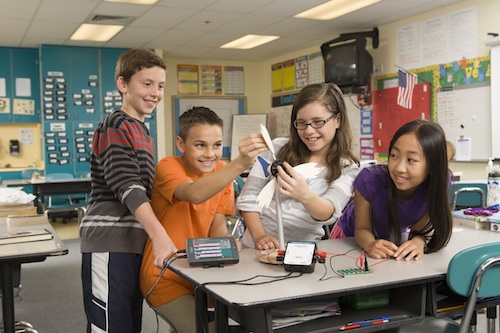
K-12 students are highly receptive to courses that get them hands-on with engineering. Image Courtesy of STEM Market Impact LLC
Latest News
May 12, 2015
While school administrators and teachers are generally onboard with the Obama Administration and Congress’ call for a heightened focus on K-12 STEM education, a number of challenges remain, including the lack of available technology to support the programs in addition to insufficient professional training.
Those were the highlights of the 2015 National Survey on STEM education developed by Interactive Educational Systems Design (IESD) and STEM Market Impact LLC to gauge the impact of the Next Generation Science Standards (NGSS). The new standards, developed collaboratively with states and other stakeholders in science, education, and industry, are intended to create a solid foundation for a K-12 science curriculum that better reflects advances in technology and education and that sufficiently prepares American students to compete in STEM-related fields at a global level.
 K-12 students are highly receptive to courses that get them hands-on with engineering. Image Courtesy of STEM Market Impact LLC
K-12 students are highly receptive to courses that get them hands-on with engineering. Image Courtesy of STEM Market Impact LLCOne of the key differentiators of NGSS is a more robust focus on integrating engineering subject matter and disciplines into science-related courses. “Before you might have had a separate class for robotics or an introduction to engineering, but the subject matter wasn’t integrated into the science class,” explains Daylene Long, founder and owner of STEM Market Reports, a key collaborator on the study. “With the new standards, students studying force would be tasked to build a bridge or other structure that demonstrated their understanding of force by applying key engineering principles.”
According to the findings, more than 60% of respondents reported an interest in incorporating project-based learning into their programs with 35.8% interested in technology, and another 35.5% interested in engineering practices. In terms of the types of experiences they were looking to provide students: Over 70% wanted to help them learn to analyze and interpret data; nearly 60% saw the ability to plan and carry out investigations as important, and 46.1% cited the ability to define real-word problems that could be solved through research and engineering. Designing solutions to real-world problems was another big priority, cited by 37.5% of respondents.
Obstacles to Overcome
While nearly half (47.8%) of respondents had a favorable impression of the next generation standards, there are still a number of obstacles impeding effective STEM education. The biggest challenge is insufficient access to technology to support the new educational programs, according to 41.5% of survey respondents, while 37.9% said class time was not enough to adequately cover all of the subject disciplines.
The majority of teachers at the elementary school level lack access to the digital tools required to support a proper engineering background, while at the middle school and high school levels, there is access to the necessary digital tools, but more than half of the teachers say they are required to share them among classrooms and labs.
Getting teachers the requisite professional training to infuse STEM — and particularly, engineering subject matter — into the courses is another big challenge. Thirty-three percent of respondents said there wasn’t enough training for professionals to successfully integrate NGSS subject matter into their classrooms.
Funding Expected to Rise
Despite the challenges, there was a high level of enthusiasm for making NGSS a reality among respondents, Long said, as well as an uptick in overall funding for STEM educational resources. About one-fourth of the survey respondents predicted an increase in spending on STEM education in 2015-2016 compared to last year, when only 15% predicted a spending decrease. This is a somewhat rosier outlook compared to the results from the 2012 National Survey, when about 20% predicted an increase in spending and more than one-third predicted a decrease, Long said.
Survey responses aside, Long said what’s really heartening is the response from students as they experience the STEM curriculum resulting from the next generation standards. “When you are studying different types of energy, including wind energy in fourth and fifth grade, the concepts can seem sort of dry,” Long recounted. “But when you ask them to actually build their own wind turbine and determine how to pitch the blade to maximize energy output, the kids light up. They really like the real-world application engineering brings to learning science concepts — it’s exciting and encouraging.”
Watch this video to get a basic background on NGSS:
Subscribe to our FREE magazine, FREE email newsletters or both!
Latest News
About the Author
Beth Stackpole is a contributing editor to Digital Engineering. Send e-mail about this article to [email protected].
Follow DE





